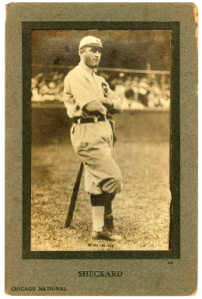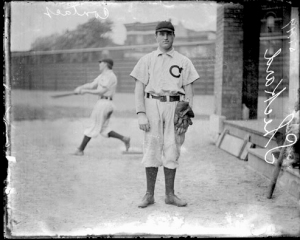Born: November 23, 1878, Upper Chanceford, Pennsylvania
The family moved to Columbia, Pennsylvania, in 1888
Died: January 15, 1947, Lancaster, Pennsylvania
Buried: Laurel Hill Memorial Garden, Columbia, Pennsylvania
“. . .he was a bigger cog in the old invincible Cub machine than he ever received credit for being.” – Johnny Evers
Samuel James ‘Jimmy’ Tilden Sheckard was a star early in the 20th century who might have made it into the Hall of Fame had he been more consistent.
Standing 5′ 9″, he broke in with Brooklyn in 1897. He played well in 1897 and 1898, showing some power, and in 1899 he spent a year with Baltimore before returning to Brooklyn in 1900, 1901, and most of 1902 before joining the new American League Baltimore team for 4 games at the end of 1902. Then, he was back to Brooklyn for another 3 years.
His 1901 season was notable, as he hit .354 with substantial power and drove in 104 runs. He led the league in slugging percentage. He also hit grand slams in consecutive days, an amazing feat, especially in the Deadball Era. It would be 77 years until another National Leaguer, Phil Garner, matched the accomplishment. In 1903, he hit .332, again with good power.
Sheckard joined the Chicago Cubs from 1906-12, which was their greatest era. They won the World Series in 1908 and won the pennants in 1906 (when they went 116-36), 1907, and 1910. Sheckard, however, was not able to play as well for them as he had earlier in the decade. While he was still an above-average player, other Cubs players were the big contributors. His best year with the Cubs was 1911, a year in which the Cubs did not win the pennant when Sheckard led the league in runs scored, partly because he had 147 walks.
He finished out his career in 1913, split between St. Louis and Cincinnati.
Bill James has pointed out that Sheckard was a very talented player who at different times in his career did many impressive things. However, he could not consistently put those talents together for a whole career. Early in his career, he led the league in stolen bases (in 1899 and 1903), once he was in the top 5 in batting average (in 1901), once he led the league in triples (in 1901), once he led the league in home runs (in 1903), whereas in the middle of his career he twice led the league in sacrifice hits (1906 and 1909), and late in his career he led the league in walks twice (1911 and 1912), and in runs scored (in 1911).
As a result, by the Black Ink and Gray Ink Hall of Fame appraisal methods developed by Bill James, Sheckard scores rather well, while by the Hall of Fame Monitor method, he scores rather poorly.
He played in approximately 2,100 games and had around 2,100 hits. His lifetime .274 batting average was hurt by playing in the dead-ball era for most of his career. His substantial number of walks gave him an impressive on-base percentage of .375.
By the similarity scores method, the most similar player is his National League contemporary Tommy Leach.
He died after being hit by a car while walking to work in Lancaster. James Sheckard is buried in Columbia, Pennsylvania.
Notable Achievements
• Holds NL record for sacrifice hits in a season with 46.
• NL record for walks in a season in 1911 with 147 (a record which lasted over 30 years).
• NL On-Base Percentage Leader (1911)
• NL Slugging Percentage Leader (1901)
• NL Runs Scored Leader (1911)
• NL Triples Leader (1901)
• NL Home Runs Leader (1903)
• 2-time NL Bases on Balls Leader (1911 & 1912)
• 2-time NL Stolen Bases Leader (1899 & 1903)
• 100 RBI Seasons: 1 (1901)
• 100 Runs Scored Seasons: 3 (1899, 1901 & 1911)
• 50 Stolen Bases Seasons: 2 (1899 & 1903)
• Won two World Series with the Chicago Cubs in 1907 and 1908

